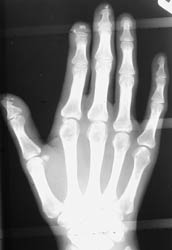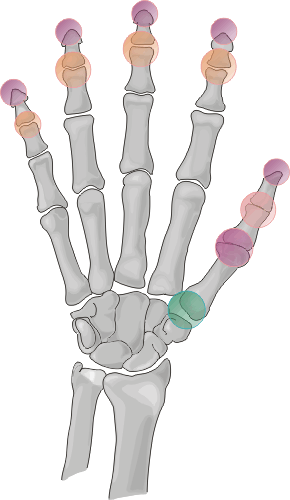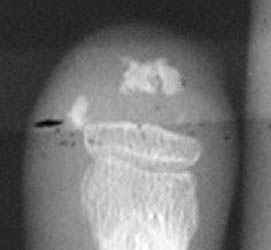 Scleroderma
is a collagen vascular disease of unknown etiology otherwise known as progressive
systemic sclerosis. There is a generalized disorder of the microvasculature
which causes and vascular compromise of the skin and other organ systems.
It is three to four times more common in women than men.
Scleroderma
is a collagen vascular disease of unknown etiology otherwise known as progressive
systemic sclerosis. There is a generalized disorder of the microvasculature
which causes and vascular compromise of the skin and other organ systems.
It is three to four times more common in women than men.
Distribution:
The distal phalangeal tips, interphalangeal joints and surrounding soft tissues
areas of the hand are the most commonly affected areas. There can also be
preferential involvement of the 1st carpometacarpal joint. Much less frequently
seen are radiographic changes at the other carpal bones.
Radiographic Findings:
Acroosteolysis can occur due to resorptive changes at the distal phlangeal
tufts secondary to pressure from surrounding sclerotic soft tissues. The resorptive
process often causes a sharpening of the phalanx, known as "penciling".
The interphalangeal joints can also exhibit erosive changes; joint space narrowing
is usually a late stage finding. Occasionally tendon sheath fibrosis can cause
contracture deformities. Radiographic findings associated with the preferential
involvement of the 1st carpometacarpal joint can include osteolysis of the
trapezium and 1st metacarpal base, 1st metacarpal subluxation, and and intra-articular
calcifications. Soft tissue subcutaneous and periarticular calcifications
and soft tissue atrophy and thickening are common findings in scleroderma.
Differential:
Rheumatoid, psoriatic, and erosive arthritis can sometimes be mistakenly diagnosed
in place of scleroderma. However, scleroderma has fairly characteristic associated
soft tissue findings which distinguish it from the others.






